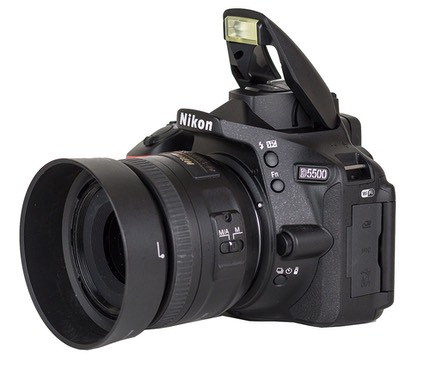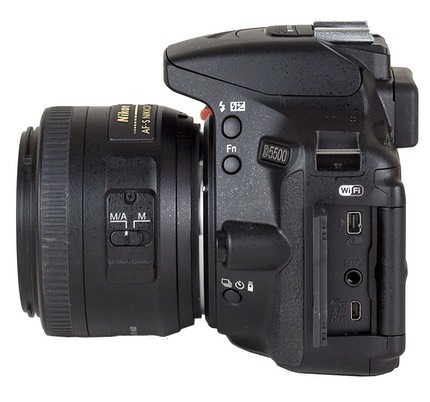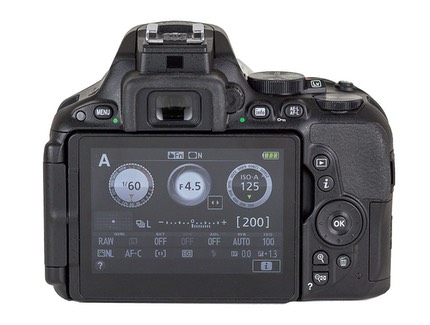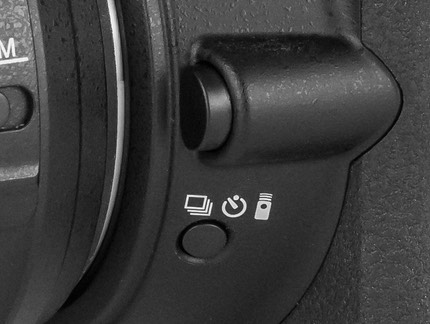Five iterations have made it excellent

What is It?
One of the first impressions the D5500 gives off to a long-time Nikon DSLR user is that it’s small. And light. So let’s start there.
The D40, which kicked off Nikon’s low-end consumer lineup back in 2006, was 471g without battery and card, while the D5500 is now 420g (14.9 ounces) measured the same way. That’s over 10% decline in weight while adding features, such as the swivel LCD.
The body itself hasn’t really slimmed from the D40, being slightly less wide but a little thicker and taller. Still, the narrowness of the body between mount and hand grip—a trait first seen in the D750—makes the grip seem more substantial and the actual body seem a bit more waif like.
Indeed, the body design is now similar to the D750’s monocoque design, which is why it’s lost a bit of girth. I don’t notice any reduction in rigidity. Indeed, the D5500 seems a bit more solid than the D5300 did, as the new design reduces parts and simplifies the chassis, and the one-piece front seems to be as solid as plastic over some form of metal chassis ever was.

Note how little “body” there is. On the left side the body almost immediately gives way to the F-mount, while on the right side the body is very narrow between the grip and F-mount.
Nikon has packed a ton of stuff into this small, light framework, so let’s take a look at the details.
Inside we have the Toshiba 24mp DX sensor with no low-pass (AA) filter, coupled with the EXPEED4 processor, a 39-sensor autofocus part, and a 2016-pixel metering sensor. The imaging sensor remains close to, if not at, the state-of-the-art for the APS/DX size, while the rest is a slightly lower specification than the top cameras Nikon makes. There are no significant changes in these items from the D5300, though (mostly some EXPEED tweaking).
Probably the one thing that some might gripe about is the 39-position autofocus sensor, the now long-in-the-tooth but reliable CAM4800DX. Frankly, I don’t see this as a big issue with this lower-priced model. Most people opting for this camera are going to stay in one of the automatic focus modes or in the central area, I think, where performance is quite good. However, note that the focus control switch on the front near the lens mount is gone on the D5500 (replaced with a self-timer/remote/frame advance button). To change autofocus modes, you’ll have to press the i button on the back and tap on the on-screen focus controls, which means you’ll always be changing focus modes with eye removed from viewfinder.
Other compromises from the higher end DX DSLRs are a 1/4000 maximum shutter speed with a 100k rating, flash sync at 1/200, a 5 fps maximum shooting speed, a 95% coverage pentamirror viewfinder, and a lack of a screw drive for older autofocus lenses (non AF-S lenses; in Sigma parlance, non-HSM lenses). As with its predecessor, the D5500 has only a Rear Command dial (e.g. no Front Command dial).
The D5500 has a built-in flash with a reasonable GN (39’/12m at ISO 100), but the internal flash cannot be used in commander mode as with higher end Nikon DSLRs. A typical Nikon hot shoe sits up top, as well, and provides full CLS/i-TTL support with Nikon’s line of Speedlights.
On the left side of the camera we have connections for Nikon’s proprietary USB, external microphone, and AV Out (special Nikon cable, supplied) under a hinged rubber door. On the right side we have another small door above the SD card access door that hides a mini HDMI connector.

Where’s the HDMI connector? On the other side of the camera. But note the overall paucity of connectors. One of the things that Nikon cuts out of the lower end cameras.
For video, the D5500 produces 1080P and 720P at frame rates from 24 to 60. On the HDMI connector it produces a clean 1080i/60 signal, at least as long as there are no complaints about card status (at which point it will display card status indicators on the signal). Unlike the higher-end DSLRs, the D5500 cannot be set to stay powered for more than 30 minutes, which limits recording video off the HDMI connector a bit. Manual video exposure can be set, though apertures can’t be changed during video or Live View shooting. Up top the camera has a built-in stereo microphone pair just in front of the hot shoe. While you can hook up an external microphone, there is no headphone monitoring jack for audio.
The D5500 uses the EN-EL14a and gets a commendable 820 shots CIPA from it. Indeed, even running video and Live View seems very well behaved in terms of battery suckage. I easily ran the D5500 for many hours (30 minutes at a time, though) shooting video without draining the battery.
Infrared remote detectors are on both the front and back of the camera, though Nikon does not supply the ML-L3 remote you need to control them. Tip: Amazon has plenty of low-cost knockoffs of this remote. You can also use an MC-D2 wired remote to the top connector on the side of the camera.
If you’re coming from a D5300, you might wonder what’s different:
- The GPS is no longer built-in
- Nikon has added the Flat Picture Control for video work
- The rear LCD is touch-enabled
- ISO 25,600 is now a numeric ISO, not HI1
- The battery life has been considerably enhanced (820 shots versus 600 CIPA)
- The viewfinder has an eye detect sensor (if you’ve got INFO set right, it’ll kill the rear LCD when you put your eye to the viewfinder)
- The D5500 is a bit smaller and significantly lighter than the D5300
The camera is made in Thailand, and like most other Nikon consumer cameras, serial numbers are now starting at 25 for the US market (as opposed to 30 previously). The body is available in black, or red.
Source of review unit: one month loan from B&H.
How’s it Handle?
One thing the small body does is cramp the right-hand position. I find the front grip hold quite good due to its increased depth, but the position of the Direction pad doesn’t fit naturally under the thumb: you swing your hand out to get your thumb on this crucial control. I don’t have large hands, so those of you with mammoth mitts are really going to find this a bit awkward.

Because the 3.2” swivel LCD takes up so much of the back of the camera, Nikon’s resorted to stacking a bunch of controls to the extreme right of the back, with the Direction pad towards the bottom of the camera. While it wouldn’t have been perfect, I think the Direction pad should have been the top control so that your hand doesn’t contort as much to use it while shooting. You don’t need the Playback or second Info button where you thumb can naturally reach it, after all. Of the controls on the back, the three you need to reach while shooting are the AE-L/AF-L button, Direction pad, and Rear Command dial. Nikon only opted to make two of those easily reachable. One note on the Rear Command dial: it’s no longer embedded near the right thumb rest; instead it sits above the camera, nestled in a cutout on the top of the camera. Small change, but one that will have some Nikon-trained thumbs searching for it.

Since I just mentioned the effects of that big swivel LCD, let’s talk about what it does to handling: in a word: speed. Nikon’s done a very good job with their touch interface, especially when it comes to menus. Do a flick up or down and you get the next page of menus naturally, not a continuously scrolling list you have to then stop with a gesture. Getting to a menu command that’s buried is fast and convenient, as long as you know where it is.
Oh dear, he’s going to go there. Stop him, quick. Oh, it’s too late…
If you’re moving between Nikon DSLRs, as I do a lot, you notice that things move. The Who Moved my Cheese menu shuffling continues unabated at Nikon, so it’s obvious that they think this is the way it should be. Why Auto Distortion Control, a function you will end up disabling and re-enabling based upon whether you’re shooting bursts of shots or not, gets buried at the end of the SHOOTING menu I don’t know, but I truly don’t know why it appears above Long Exposure NR on my D750 and below it (by three menu choices) on the D5500.
So it’s another of those Nikon giveth/taketh things. The menu system on the D5500 is snappy and great to use with the touchscreen on the D5500. But for no apparent reason menus items move between cameras. The SETUP menu is a great example. Image Comment and Copyright Information have moved to the number two and three positions, while Clean Image Sensor now languishes down a page. And why things that are Custom Settings on the higher end cameras migrate to the SETUP menu on the D5500—which still has Custom Settings, after all—is totally beyond me.
Still, menu hopping is so much easier with the touchscreen that I’d basically say that every Nikon DSLR ought to have a touchscreen, not just a random camera or two. Couple touch-everywhere with a really stable menu system and Nikon cameras would establish themselves as the design to beat. As it is, it’s just a good design with constantly changing menus that is just getting downright annoying.
Along the same lines, if you’re looking for the Fn (function) button, it’s not on the right side of the camera (as you hold it). It’s not even next to the lens, as usual. Instead, it’s the button button on the left side of the prism (under the Flash Release/Options button).

Note how indented and flush this button is to the surface of the body. This is typical of the D5500 controls, unfortunately.
Another of the handling changes is the missing autofocus area/mode control as a button/lever. Instead, we have a frame advance button (including self timer and remote) sitting in that position under the lens on the front right of the camera (user left from the rear). Worse still, the button is really indented, making it difficult to find by touch. Indeed, most of the buttons on the D5500 are tough to find or distinguish by touch. This makes the D5500 a camera where the user must make deliberate moves to change things, not quick eye-at-viewfinder presses. I suppose this matches the target customer for the camera, but never-the-less I don’t think it’s optimal design.
If you have no other Nikon DSLR or the D5500 is your first, you probably won’t have any real handling issues at all, other than perhaps the cramped hand position and very small, indented buttons. If you have another Nikon DSLR and the D5500 is your backup/supplement, all the moving of controls and menu items around will make for a bit of frustration as you move back and forth between your cameras, I think.
How’s it Perform?
Video: Here’s something I noticed on the D5500 when recording external video. I’m now going to have to check on the other Nikon DSLRs to see if they do the same thing, as I don’t remember encountering this before. If I’m recording video externally from the HDMI connector and the card in the camera is full, the recording and card indicators appear on the signal. This freaked me out at first when I was trying to do external video recording with an Atomos Ninja Star connected to the D5500.
Overall, video performance is pretty much in line with the other Nikon DSLRs these days: reasonably capable (28Mbps bit rate) 1080P at 24 to 60 fps. The signal on the HDMI connector is clean, though only 8-bit 4:2:2. You also can’t restrict the HDMI signal to Limited Range (for broadcast-ready video) as you can on the higher-end Nikon DSLRs.
Note that if you record to a card in camera, you’re limited to 20 minutes or 4GB in size, whichever comes first.
You really can’t rely on autofocus when recording video. The AF-F (full time) mode does a lot of slow hunting when subjects move. Moreover, the focus makes enough sound even with some of the quieter lenses to be picked up by the camera’s microphones.
Card/Buffer: Nothing earth-shattering here. Lower cost cameras use lower cost parts, so you won’t find that the D5500 responds to cards faster than 45Mbps (there may be some small advantage to faster cards, but it’s not due to the speed of the write mechanism). The big issue is the limited buffer.
Best case raw buffer is 14 images, though turning on Long Exposure Noise Reduction or Auto Distortion Control will reduce that. If you use 14-bit instead of 12-bit, that drops to 10 shots and the frame rate drops by 1 frame per second.
JPEG shooters shouldn’t have any real issues with the D5500 with a 45Mbps of faster card, though: the camera should reach the 100-frame limit at any JPEG setting.
Autofocus: Nothing new here. I can’t really detect any difference between the D5500 and its predecessor for still photography focus. Reasonably snappy, even in low light, especially if you’re using the middle nine sensors. Continuous autofocus is also darned good, though every now and then I see it do a temporary, small overshoot on fast motion, something I rarely see on the higher end Nikons. I’d still judge the autofocus system to be excellent, though. Pretty much what you expect from a DSLR shooting stills. Also, don’t forget that you can “touch focus” using the LCD in Live View now, too.
Sensor: Again nothing seems truly new here. Indeed, the changes, where I detected any, tend to fall within sample variation levels and would never be visible in the JPEG samples I can post here, so I won’t bother.
The 24mp sensor in the D5500 has been thoroughly vetted at this point. It’s basically state-of-the-art when it comes to DX (APS) size sensors. Perhaps there’s a slight improvement in the very, very deep shadows, but in all my testing, it doesn’t really measure any differently for raw shooting than the D5300 before it.
JPEGs show some very slight differences, though. It appears that Nikon has once again tweaked their noise reduction a bit. I see slightly less low-level detail smearing in the noise reduction with the D5500 than I did with the D5300. On the other hand, that also makes the noise a bit more defined at the highest ISO values. Put another way, Nikon appears to have opted for edge acuity (plus a bit of contrast) and clearly defined noise as opposed to smeared edges and slightly less visible noise. It’s subtle and near impossible to show with JPEGs on a Web page, but it’s definitely a change. Whether it’s a change for the better is another story. Some will like the new approach, some the old. Personally I prefer less smear, so approve of Nikon’s choice here.
Overall, the D5500’s image quality remains excellent, basically as good as you can expect from a DX (APS) crop sensor camera at the moment.
Final Words
The D5500 and D7200 were both in my bag and on my desk at the same time as I was working through this review. Simply put, the D7200 is the better camera. Other than Nikon’s silly decision with the swivel touchscreen LCD being exclusive to the D5500, virtually every aspect of the D7200 has a performance or feature benefit that the D5500 gives up. Okay, the sensor is essentially the same, though the D7200 is slightly more adept at using it (having a 1.3x crop mode, for example).
There’s no doubt that the D5500 is the little brother, literally, when the two bodies are set side by side. And given the pricing, that’s pretty much how it should be.
Aside: it’s a shame that the only DX lenses that Nikon has created that play into that “smaller, lighter” aspect of the D5500 (and D3300) are the 35mm f/1.8, and the 18-55mm and 55-200mm kit zooms. The D5500 really cries out for a compact wide, normal, telephoto prime set, and a small and modest mid-range zoom that’s improved over the kit choice, such as a 24-70mm (equivalent) f/4. Once you get into the larger lenses (e.g. 18-140mm), the small/light advantage of the D5500 starts to go away.
You also have to consider the smallest sibling in the line, the D3300, which also uses a near-state-of-the-art 24mp sensor. From an image quality standpoint shooting JPEG there’s not much to distinguish between the three current DX cameras now. Raw shooters should probably avoid the D3300, which only provides 12-bit lossy compression. While the D5500 also provides only lossy compression, the 14-bit option does retain a bit more data integrity than the D3300 provides at base ISO in the deep shadows. If you’re a serious raw shooter, only the D7200 is going to give you a full, lossless data set, though.
All that said, I’d tend to pick the D5500 over the D3300 even for JPEG shooting: it just handles better, and that swivel touchscreen is a big improvement.
These days, though, the D5500 has to fight for sales with a lot of highly competent mirrorless cameras. The things that allow it to win that fight are: (1) state-of-the-art DX sensor; (2) swivel touchscreen; and (3) excellent autofocus performance, even with telephoto lenses and moving subjects. Still, the Olympus OM-D E-M10 comes to mind as a small, highly competent camera that is even more compact and light than the D5500, all at a lower price. Likewise the Sony A6000 is also smaller and lighter, plus uses a similar sensor to the D5500, while also coming in at a slightly lower price. And this area is growing more and crowded, with the recently announced Fujifilm X-T10 and Panasonic G7 also now shipping in the same price range.
Here’s the thing: if you value F-mount lenses, you need to photograph fast moving subjects, or you need to use telephoto lenses, the D5500 is still the choice over those mirrorless cameras. If all you’re doing is sticking to the traditional 24-70mm (equivalent) focal range with only occasional need for tracking moving subjects, those mirrorless cameras start to look tempting. In essence, Nikon’s done just enough in reducing the size and weight of the D5500 while retaining it’s DSLR-ness to stave off another round of mirrorless competitors, I think. It’s just a shame that we’re seeing better optics choices pop up for those mirrorless cameras while Nikon sits on their FX butt (what makes me want to break into a chorus of “I like FX butts and I will not lie…”? ;~).
As with all of Nikon’s DX DSLRs, the camera itself is excellent. We can quibble on the details of handling or feature choices, but the ultimate results—in focus, properly exposed, good looking images taken in almost any situation—remains what these cameras do best. It’s what the D5500 does best: great-looking images in almost any situation you can throw at it. Plus frankly good video when you need it, as long you don’t need autofocus.
But I don’t think it’s a surprise that we’re already seeing US$150 instant rebates (17% discount) on this camera even though it hasn’t been out very long. The competition in the sub-US$1000 interchangeable lens camera market is intense. At the current pricing as I write this review, the D5500 is certainly a camera you need to consider, even if those mirrorless options are tempting you.
Was Recommended from 2015 to 2016
